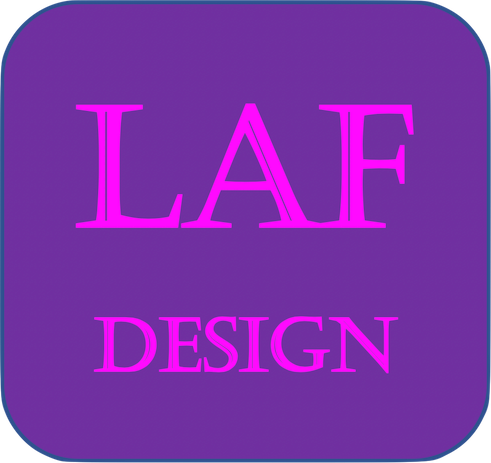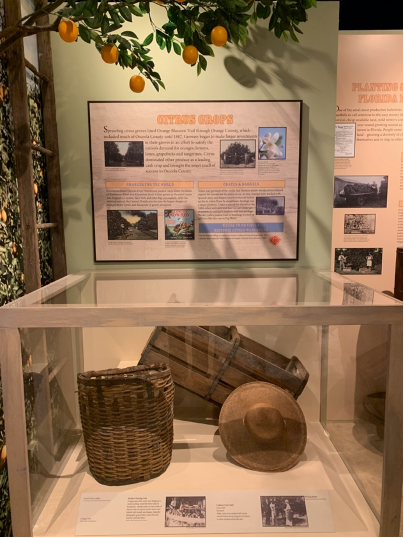This final project for IDT574: Digital Media and Learning Applications was a proposal for a new interactive exhibit on Citrus Crops for the Osceola County Welcome Center and History Museum. The proposal addressed ways to make the exhibit more accessible for the Spanish-speaking population as well as large-budget and small-budget ideas for making the exhibit more interactive.

logo
Design Proposal for the Osceola County Welcome Center and History Museum, Citrus Crops Exhibit

Current Citrus Crops exhibit at the Osceola County Welcome Center and History Museum
Language Accessibility
We at LAF Design understand the importance of communication. The museum needs to be able to communicate the information in this exhibit in Spanish and English. With an extensive local Spanish-speaking population, the museum must be able to provide the information for their visitors in Spanish and English. It is not enough to expect a Spanish-speaking museum employee always to be available. According to Coster, “to be effective, translating input would need to be absolutely correct. Bad translation can be quite detrimental” (Coster, n.d.). We cannot just take what exits and run it through Google translate or a similar program because those translations often do not make sense. We will translate all of the spoken and written text with the help of a native Spanish speaker. If no Spanish-speaking tour guide is available, guests will have the option to have a self-guided tour with a Spanish recording. “We need to ensure that our translations do not look careless and are not translated incorrectly and end up being offensive” (Fordice, 2014). For the text display shown in the picture above, we will duplicate this poster and translate the written text into Spanish. The two presentations will be posted side by side. Museum guests then have the option to read the information in Spanish or English.
Large Budget Technology
With access to a large budget, the museum could utilize much technology to make the exhibit more interactive and engaging. “An interactive multimedia application for a museum must meet the needs of the curator, the interests of the visitors while maintaining function, and fit into the existing museum exhibition structure” (Whitehead & Sebastian, 2010). We recommend replacing the existing text posters with interactive whiteboards that guests can touch. The first screen would give guests the option to choose if they want to experience the exhibit in Spanish or English. Once guests choose their preferred language, they will read about the exhibit and interact with the content through various games on the interactive whiteboard. Guests would also have the option to have the text read to them in either Spanish or English. There will be a trivia game, asking guests about the information learned at the exhibit, as well as a timed Pick and Pack the Citrus game. First, the player must pick as much citrus as possible in a minute, and then they have to pack as much as possible in a minute. Citrus fruit pickers and packers were not timed in real life, but this game will be a fun and engaging activity for children and adults alike so that they can get a glimpse of the good old days in Central Florida. This game could also be available in a VR format if the budget allows it. A variety of songs about Florida, including “Old Folks at Home,” “Where the Sawgrass Meets the Sky,” and “The Florida Song,” to name a few, will play softly in the background as guests move through the exhibits.
Limited Budget Technology
With a limited budget, we can still incorporate many interactive elements, just in a different format. Interactive whiteboards are not a feasible option with a limited budget, but we could still utilize the same technology in a free app that guests can download on their smartphones. The app would be very similar to what would have appeared on the interactive whiteboard; it will open to a page that prompts guests to choose if they want to experience the exhibit in Spanish or English. “Anyone who has ever mounted an exhibit of virtual objects that visitors to the space can easily access themselves with their own computer or mobile device knows instinctively that what museums offer is an experience, which is one with a narrative that ultimately pulls works together in a way that compels visitors to think more deeply or differently about the work, the ideas put forth and their own views and perspectives” (Grigar, 2013). The museum could leave the current exhibit but add a poster next to the current one, with the Spanish text. There would be a button to press next to the corresponding poster, which would read the text to the guest. The technology used for this could be an iPad or other tablet installed in the display, or it could be as simple as a soundtrack that you would find inside a toy. This way, guests who do not have a smartphone could still experience the exhibit in Spanish as well as English.
References
Coster, A. (n.d.). Gift of gab comes in three languages. MX.
Fordice, S. (2014). At the corner of diversity and communication. Education Digest, 79(6), 22-25.
Grigar, D. (2013). Virtuality and the art of exhibition: Curatorial design for the multimedial
museum. Leonardo, 46(5), 509. https://doi-org.oclc.fullsail.edu/10.1162/LEON_r_00664
Whitehead, A., & Sebastian, F. (2010). History or his-story: Reflections on interactive museum exhibit design. Design Principles & Practice: An International Journal, 4(1), 453–463. https://doi-org.oclc.fullsail.edu/10.18848/1833-1874/CGP/v04i01/37825
